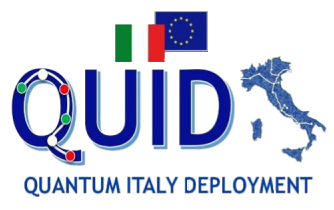QUID will contribute:
- to long-term policy objectives of the call
In fact, the call aims at the initial steps towards the national full-deployment of quantum communication infrastructures to be harmonized in an EU frame, called EuroQCI, composed of a terrestrial and a space segment. QUID deploy the initial infrastructure with all the building blocks to be demonstrated and with their first use and exploitation. There is not any aspect of EuroQCI frame that is not covered by QUID. Of course, QUID target intial steps, that means that QUID is not going to cover all the national territory and all the potential user with infrastructure, devices and operations. Nonethelss, we will build a solid framework with a rational and effectrive view for extensive consolidation tin the follow up. In this sense, QUID is the solid base of the long term policy. - to the relevant policies and strategies
Indeed, not only the long term is considered by QUID, but also short and medium term. This is obtained consolidating the supply chain at the EU level, allowing involved companies to build initial steps together with public actors and academics. This is offering the correct opportunity to deploy technology and to consolidated a strong relationship towards R&D and innovation, since the Quantum Communication deployment will face in next years also the need to compare to strong and dynamic technology changes (both linear improvements, and disruptive changes).
QUID builds also on the focus points addressed by the EC Flagship for Quantum Technologies. - to build on a sound needs analysis in line with the activities at European and national level
QUID is based on the analysis of partners that are all involved with the EuroQCI construction, in dedicated funded project and in close institutional relationships.
This analysis includes a national evaluation of needs and capabilities, and the evaluation to positioning Italian companies and institutions in a pro-active role in EuroQCI. Use cases and insutrail context has been addressed both by European Commission and private institutions, e.g. the Capgemini Research Institute, “Quantum technologies: How to prepare your organization for a quantum advantage now”, 2022 (https://www.capgemini.com/insights/research-library/quantum-technologies/). For Quantum Technologies in general and Quantum Communication in particular, the report addresses large investments in Europe and China. Among leading examples in Europe, we address the Dutch Hub “Quantum Delta” (https://quantumdelta.nl/)
In Italy, QUID will be complementary to the MUR initiative to build a Private-Public Partnership on Quantum Technology building on the EC Recovery and Resilience Fund
(https://www.mur.gov.it/it/news/mercoledi-16032022/pnrr-mur-pubblicato-bando-supartenariati-attivita-di-ricerca) - to address the relevant challenges
QUID deploys a terrestrial national QCI with a significant coverage of Italian territory, and involving a significant number of QKD nodes and different scenarios (different users, metropolitan, regional, free space domains). This would give also the possibility to have a good amount of information about real-field challenges in a complete network scenario. Moreover, addressing challenges is possible only if needed resources and expertise are present. In this sense, QUID offers a world leading team with the complete set of skills, assets, and capabilities - with objectives specific, measurable, achievable, relevant and time-bound within the duration of the project
QUID proposes an accountable set of activities. Each WP and activity is tightly bound to sound metrics in deployment: number of nodes, number of defined use cases, location of the nodes and of the relevant geographical connections. All the objectives are time-bound within the duration of the project by a realistic workplan building on already existing skills and TRLs.
QUID will reinforce and secure the digital technology supply chain in EU in four main ways.
First, there will be a direct involvement in fostering EU technology manufacturing, since QKD devices in QUID are mainly produced by EU companies. This point is critical and crucial, since till few years ago EU companies were not present in the market segment of QKD devices manufacturing.
Second, QUID deploys all the components of the supply chain: mainly, the chain Device Manufacturing – Infrastructure enabling – Device and Infrastructure integration – Management – user engagement. This document describes in details how this attention to the complete supply-chain has been addressed, combining the involvement of all the partners with the needed competences, and the relevant infrastructure and use case to demonstrate an effective first exploitation, to be consolidated in the follow-up.
Third, QUID addresses also the digital technology supply chain in EU from the point of view of coexisting digital platform. QUID addresses at least 3 digital-based platform:
- QKD deployment, i.e. a quantum layer deployment in digital technology;
- traditional communication platforms: traditional digital technology looking at including quantum communication in a smooth and market-effective transition from traditional to full quantum.
QUID focuses on QKD, where this transition is mature enough to be deployed, with coexistence for the two platform – quantum and traditional communication. This is important from a technical point of view, and for the deployable business model. QUID includeds 2 telecommunication operators exploiting first QKD integrations; - digital platform for services like time synchronization, represented by services already existing on the infrastructure, that will benefit from QKD for more secure time distribution.
Fourth, QUID addresses security over digital technology supply chain, with quantum and traditional integration. QUID involves the most qualified actors in Italy (Telsy, LDO).
